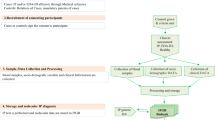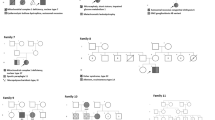Abstract
A locus for the X-linked dominant genodermatosis incontinentia pigmenti (IP) has been linked to markers in Xq28. Here we report high lod scores for markers spanning the interval DXS52-DXYS154 using 16 families, providing further evidence for a single major X-linked IP locus.
Similar content being viewed by others

Introduction
Incontinentia pigmenti (IP) or Bloch-Sulzberger syndrome (McKusick No. 308300) is an X-linked dominant genodermatosis that predominantly affects females. The spontaneous abortion rate as well as the female:male offspring ratio for carriers is consistent with lethality in males. Characteristically, newborn affected females present with erythematous blistering that evolves into verruccous lesions followed by streaks and whorls of hyperpigmentation. These hyperpigmented lesions are prominent in the axillae and groin and eventually fade leaving superficially scarred, hairless, pale tissue as the only dermatological sign in adulthood. IP is often associated with developmental abnormalities of the teeth, eyes, hair and the central nervous system [1, 2]. The most obvious clinical signs present in adulthood are the dental abnormalities, affecting 80% of cases. They include hypodontia, delayed eruption and malformed crowns.
Reports of several isolated females with clinical signs similar to IP and Xp11/autosome translocations lead to the hypothesis that a gene in Xp11 was responsible for IP. However, genetic linkage analysis in families with classical X-linked transmission of IP has excluded this region [3, 4] and provided evidence for a locus in Xq28. Genetic linkage to markers in distal Xq28 (DXS52-Xqter) has been established with a few recombinant chromosomes providing proximal boundaries to the gene location [5–7].
Here we present results of further genetic linkage analysis aimed at localising the gene for IP in distal Xq28 using 16 families with X-linked dominant disease.
Materials and Methods
Families
All cases were ascertained by SL or SLY using criteria described by Landy and Donnai [2]. Clinical manifestations were highly variable but all families contained at least one female with skin lesions typical of IP from the newborn period onwards. IP was considered familial if female relatives showed more than one of the following: characteristic skin manifestations, abnormal dentition, retinal disease, linear atrophic hairless regions of skin, more than one affected daughter, multiple male miscarriages. No male cases were found and there was no evidence of consanguinity. 15 of the families have not been previously described. Family 3 was described in Curtis et al. [8] and typed for F8C and DXS52. These and additional markers were used for the present study (fig. 1).
DNA Polymorphisms
Blood samples were collected with informed consent. Families were typed for DNA polymorphisms DXS52 (St14, VNTR), F8C (CAn), RCP/GCP (colour vision DAn), DXS1108 (CAn) and DXYS154 (CAn). CA repeats were all resolved on 1-mm-thick, 12% acrylamide gels [Accugel (Flowgen)] containing 7M urea and buffered with 1XTBE. Gels were silver-stained as described previously [9].
Linkage Analysis
Data were analysed by JY using the LIPED [10] computer programme for two-point analysis. Confidence intervals were obtained by taking values of the recombination fraction corresponding to a lod score one unit less than the maximum.
Results and Discussion
A total of 16 families representing samples from 52 affected females, 13 unaffected females and 36 healthy males were used for the present linkage analysis. Highly significant two-point lod scores were obtained for all markers used except for RCP/RGP which was rarely informative (table 1). No cross-overs were found either between marker loci or between the entire haplotype and IP.
Previous reports have provided strong evidence for a single major locus for X-linked IP in the distal portion of Xq28. Several cross-overs have indicated that the gene may lie in the telomeric portion of the chromosome and multipoint analysis strongly favours a location between F8C and the telomere (3.105 times more likely than a more proximal location between DXS52 and F8C) [7]. Sefiani et al. [6] described three cross-overs in a healthy boy and two affected girls in a single family that placed the gene distal to DXS52, R/GCP and factor VIII, respectively. The latter cross-over suggests that the gene is within the terminal 1-Mb region of DNA by comparison with physical maps [11]. In all three cases more distal markers were found to segregate with the disease.
We have typed distal markers in 16 families. High lod scores obtained with all markers support the existence of a single major locus close to the factor VIII gene. No crossovers were observed across the haplotype DXS52-DXS154 which represents about 3.7 Mb by comparison with physical maps. In view of the lack of recombination in the large cohort presented here further genetic analysis may have limited value in narrowing down the position of the disease locus. Direct screening of the many candidate genes now described for the region may therefore be a more fruitful approach.
References
Carney RG: Incontinentia pigmenti. Arch Dermatol 1976;112:535–542.
Landy SJ, Donnai D: Incontinentia pigmenti (Bloch-Sulzberger syndrome). J Med Genet 1993;30:53–59.
Harris A, Lankester S, Haan E, Beres J, Hulten M, Szollar J, Soutterr L, Bobrow M: The gene for incontinentia pigmenti: Failure of linkage studies using DNA probes to confirm cytogenetic localization. Clin Genet 1988;34:1–6.
Sefiani A, Sinnet D, Abel L, Szpiro-Tapia S, Heuertz S, Craig I, Fraser N, Kruse TA, Frydman M, Peter MO, Schnutz JL, Gilgenkrantz S, Mitchell G, Frézal J, Melançon S: Linkage studies do not confirm the cytogenetic location of incontinentia pigmenti on Xp11. Hum Genet 1988;80:282–286.
Sefiani A, Abel L, Heuertz S, Sinnett D, Lavergne L, Labuda D, Hors-Cayla MC: The gene for incontinentia pigmenti is assigned to Xq28. Genomics 1989;4:427–429.
Sefiani A, M’rad R, Simard L, Vincent A, Julier C, Holvoet-Vermaut L, Heuertz S, Dahl N, Stalder JF, Peter MO, Moraine C, Maleville J, Boyer J, Oberlé I, Labuda D: Linkage relationship between incontinentia pigmenti (IP2) and nine terminal long arm markers. Hum Genet 1991;86:297–299.
Smahi A, Hyden-Granskog C, Peterlin B, Vabres P, Heuertz S, Fulchignoni-Lataud MC, Dahl N, Labrune P, Marec BL, Puissan C, Taieb A, von Koskull H, Hors-Cayla MC: The gene for the familial form of incontinentia pigmenti (IP2) maps to the distal part of Xq28. Hum Mol Genet 1994;3/2:273–278.
Curtis ARJ, Lindsay S, Boyle E, Clarke A, Landy SJ, Bhattacharya SS: A study of X chromosome activity in two incontinentia pigmenti families with probable linkage to Xq28. Eur J Hum Genet 1994;2:51–58.
Jouet M, Rosenthal A, Armstrong G, MacFarlane J, Stevenson R, Paterson J, Metzenberg A, Ionasescu V, Temple K, Kenwrick S: X-linked spastic paraplegia (SPG1), MASA syndrome and X-linked hydrocephalus result from mutations in the L1 gene. Nature Genet 1994;7: 402–407.
Ott J: Estimation of the recombination fraction in human pedigrees. Efficient computation of the likelihood for human linkage studies. Am J Hum Genet 1974;26:588–597.
Freije D, Schlessinger D: A 1.6-Mb contig of yeast artificial chromosomes around the human factor VIII gene reveals three regions homologous to probes for the DXS115 locus and two for the DXYS64 locus. Am J Hum Genet 1992;51:66–80.
Acknowledgements
This work was funded with the support of the Medical Research Council. We would like to thank Jane Dickinson for providing ophthalmological details and Charles French-Constant for clinical discussion.
Author information
Authors and Affiliations
Corresponding author
Rights and permissions
About this article
Cite this article
Jouet, M., Stewart, H., Landy, S. et al. Linkage Analysis in 16 Families with Incontinentia pigmenti. Eur J Hum Genet 5, 168–170 (1997). https://doi.org/10.1007/BF03405895
Received:
Revised:
Accepted:
Issue Date:
DOI: https://doi.org/10.1007/BF03405895



